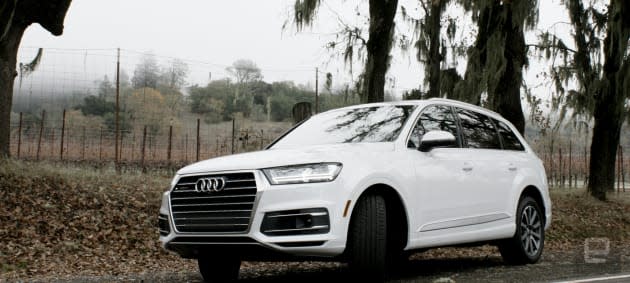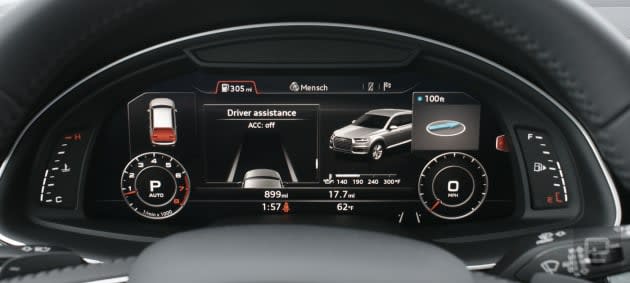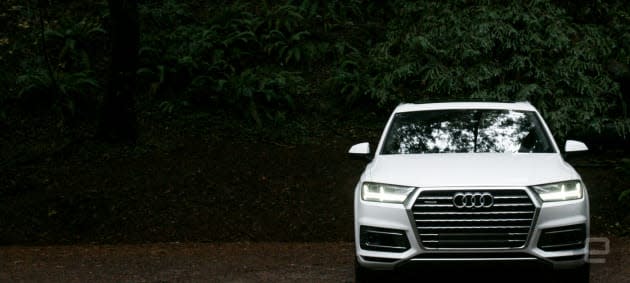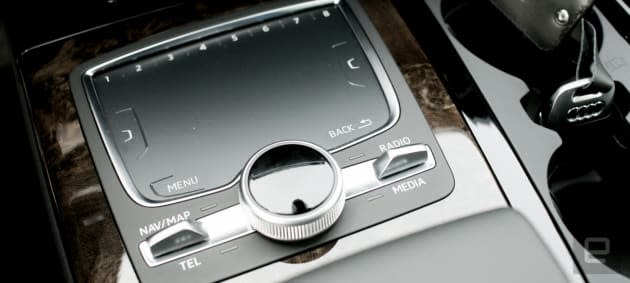Audi's Q7 SUV tries to make you a better driver
And it's fun to drive, too.

I'm sitting in the passenger seat of the new 2017 Audi Q7 as it prepares to turn left. Another car is barreling towards us in the opposite lane. An Audi engineer sitting behind the wheel assures me everything will be fine. Suddenly, at the last minute, the driver turns the wheel and punches the gas. We should have lurched into path of the oncoming vehicle and caused an accident. Instead, the car's onboard safety technology slammed on the brakes and alerted the driver to the mistake. This all went down on a closed course in Northern California, but it happens all the time to real drivers on real roads. Audi is hoping to reduce those incidents with an SUV that's not just smart, but actually fun to drive.
While the Audi e-tron we saw recently is the company's plug-in hybrid, the Q7 is its flagship SUV. It's a refined all-wheel-drive vehicle with top-of-its-class acceleration (zero to 60 in 5.7 seconds) with seating for seven. But it also ushers in technology that keeps the driver (and all those passengers) safer. The Q7 counteracts your bad habits, or at least attempts to by nudging you back into your lane and stopping the car before you hit a pedestrian or other vehicle. In short, it's the nanny of cars. But not the boring babysitter that makes you eat broccoli and do extra credit homework before your parents get home. Instead, it's Mary Poppins, guiding you down the right path while making everything funner than it should be.

Because let's be perfectly honest here. You're probably a bad driver. You tailgate. You wait until the last minute to brake at stop lights. You insist on racing everyone on the road and you really need to stop texting, tweeting, Facebooking and Snapchatting while you're behind the wheel. The Q7 might not cure you of your on-the-road shortcomings, but it adds an extra level of safety. While you might be distracted, the car's pre sense system of cameras and sensors is always watching.
The standard "city" feature with pedestrian and vehicle detection and a braking system can mean the difference between a warning from the car and a potentially life-threatening collision. During demos on a closed course when the vehicle was speeding toward a foam-core car or child-sized mannequin, the Q7 gave the driver the opportunity to either brake or steer around the object. If the driver fails to react, the seat belts tighten and the brakes engage to bring the car to a complete stop just short of the object. Just for good measure, it also closes the windows so that in case there's an impact minimal debris will make its way into the car.

While the semi-autonomous features of the SUV are part of a larger journey toward fully self-driving cars, I can't stress enough how important the baby steps being made by automakers like Audi and Tesla are. The chance to sit back and relax in your car while it drives you to work makes the future sound very chill. In reality, these cars will be more than just napping machines. They will reduce accidents on the road by taking you (and your horrible driving) out of the equation. An auto-braking feature should squelch the concerns of a driver who's wary of autonomous vehicles the first time it keeps them out of an accident.
For now, at least, the Q7 is somewhat autonomous. While safety is a huge selling point, removing stress from the daily drive is also one of the company's objectives. The active lane assist and adaptive cruise control features make commuting slightly less infuriating by matching the speed of the vehicles directly in front of your while maintaining the speed limit and keeping you centered in the road. On the freeway it's great, but on two-lane back roads its ability to implement the lane tracking while navigating sharp curves is especially impressive.

While driving the curvy mountain roads of Northern California, the Q7 tracked both the vehicle ahead of me and speed limit signs along a narrow two-lane path. It kept me a safe distance behind the car in front of me, and slowed to a more pedestrian-friendly speed when we passed through various towns along the way. There was a moment when the vehicle felt like it was entering a hairpin turn too quickly, which is a good reminder to pay attention and that we're not ready to give up the steering wheel just yet.
The active lane assist is equally impressive, but can be a bit overzealous. While hitting corners, the steering wheel consistently tried to adjust the placement of the car. Get too close to the yellow or white lines and the wheel nudges the vehicle to the center of the lane. If you're holding onto to the wheel even with one hand it's easy to overcome, but it can be annoying. It wasn't so much a fight with the car; more of a low-key argument in which the Q7 insisted on having the last word. After adjusting the lane correction to "late" instead of "early" the nudging became less of an issue. On the open freeway, though, it's helpful for those moments when you might not be paying attention because, again, you're a bad driver.
While lane assist is clearly not intended for someone to drive without their hands on the wheel, I tried it and was impressed how well it kept the car from careening into a ditch or oncoming traffic. After a few moments the vehicle realized what I was doing and insisted I take the wheel, which I was glad to do.

The 3.0-liter supercharged V6, 333 horsepower Q7 handles better than any SUV should. Carving through the twisty redwood-lined roads of Northern California the car felt like operating a sedan. The engine and eight-speed automatic Tiptronic transmission reacted quickly with a stomp of the accelerator from a dead stop or while passing without the Q7 jerking between gears.
Continuing our tour, the interior feels high-end but not ostentatious. Audi has also flattened its dashboard infotainment menu structure to make fine tuning the driving experience easier. About 80 percent of the time getting to where you want to go within its MMI system is quick and easy, thanks to the round navigation button and touchscreen. But there were times when finding a feature seemed unnecessarily complicated. That said, there are dedicated buttons for the most frequently used features (navigation, telephone, media) so that you don't have to reach up from the center console.

Even if you removed the tech and fancy navigation system, anyone looking for a high-end SUV should definitely give the 2017 Q7 3.0 TFSI Quattro (starting at $54,800) a spin before throwing down the cash for a BMW X5 or Mercedes GLE. But it's the technology that makes it special and most of the time, it's a welcome addition to an outstanding driving experience.



































